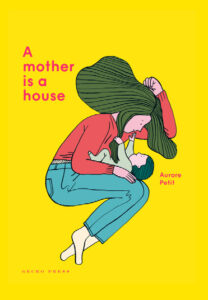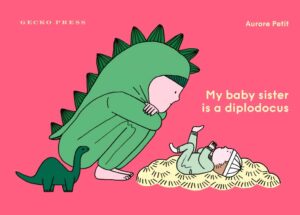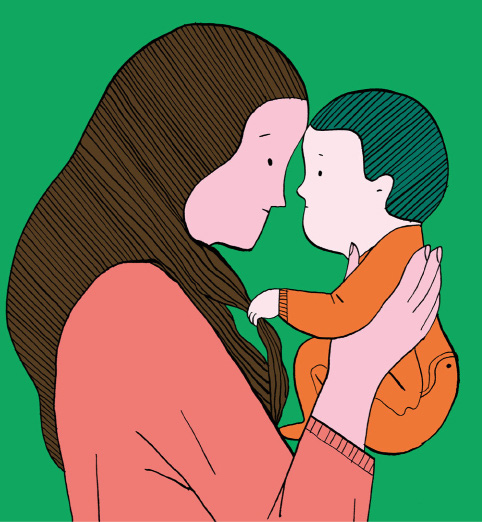Aurore Petit grew up in Haute-Savoie in the French Alps and lives in Nantes. She trained at the School of Decorative Arts in Strasbourg and has been writing and illustrating her own children’s books for 10 years. She writes and illustrates for a range of ages, from the very young to picture books. Petit has worked with choreographers and directors to adapt her books for the stage. Her books with Gecko Press are A Mother Is a House and My Baby Sister Is a Diplodocus.
You have written a number of books about family—can you talk about that?
What interests me is not so much the subject of family as the daily life of children. I watch them live, and sometimes I witness a scene and say to myself: this situation speaks volumes, it really tells me something about the relationship that a child or a baby has with their world, their people, their objects, the spaces that surround them. So I would say that I am not concerned with the subject of family, rather, I try to talk about those powerful moments that I observe children going through, foundational moments. It turns out that, in a child’s world, family comes first.
What role do you think picture books can play in children’s lives?
I think it is very important to give books to very young children, even babies. First for them to become familiar with this object, which, after all, is timeless. Of course, babies also train their fine motor skills, turning the pages carefully. The book in these early years is a shared object, because they need an adult to read with. And their relationship with the book is physical: reading on the floor, upside down…
As children grow up, reading a picture book is a way to name and identify everything, enlarge their vocabulary, to understand and discover the diversity of the world. After that, reading illustrated stories is a way to feed imagination, encounter situations that could link with their own reality and, through this, find answers and solutions to their issues.
Reading is a way to feel empathy. The way a character lives adventures, reacts with friends, manages relationships, and resolves issues is inspiring. Actually, I think it’s the same for adults: reading is a way to learn, to find stories that relate to our own lives and help us to understand ourselves and others.
How does the bright, contemporary style of your books relate to their subject?
I’m really attached to the aesthetic of the book and the graphic design. For example, I choose the position of the text and illustrations from the start. These choices are defined by the text: who is speaking? From where? Is there dialogue? Is there an omniscient narrator?
In the same way, the format of the book and composition of the illustrations correspond with the content. For example, in My Baby Sister Is a Diplodocus, I wanted to tell the story from the baby’s height. That intention immediately determined the landscape format.

In details, it guides me to manage the point of view of the illustration: at ground level when it’s focused on children, top view when I want to draw attention to the adult point of view.
In my most recent book Grande! (Big), I put the main character in the centre of each illustration, with the child’s surroundings (parents, brother, background) offscreen. The book is about the “terrible twos”: the character feels she’s the centre of the world, doesn’t see that there are people caring for her.
I like it when the graphic choices, rhythm, framing and every tool used to tell the story fits with the subject, in everything I do. Aesthetic inspires content, and content inspires aesthetic.
What is your process for creating the illustrations?
There are several steps. Usually, I first draw something really small and rough in my sketchbook; my ideas come when I’ve got a pen in my hand. When I know what I want to do, I move to my iPad, to make a second rough. This one is more built: the iPad is practical for changing proportions and the size of the elements and composing the illustration. It’s also useful at the storyboard phase, because you can copy elements from one image to another, and save time. But I don’t feel so much pleasure on the iPad, so I always move quite quickly back to paper.

When everything is resolved (writing, characters, background, composition), I print this draft, and then it’s hand drawn. I use a light table and a black pen, or tools like brush with Chinese ink. Ten years ago, I illustrated several books with colouring pencils, but now I prefer using digital colours. I like using Pantones, and play with the techniques of printing, using fluorescent colors, or shades that you can’t have with traditional techniques.
Your books appeal to both adults and children. Is that important to you?
My personal projects are often made for both children and adults. Creating this kind of “double reading” is part of my process of making a book. Parents recognise themselves in these books; they create a bond between adults: we tell each other about our experiences as parents at book events. It is intimate and universal at the same time. I like it a lot.
What do you think is the value of travelling as part of a festival like Picture Me?
I feel really grateful to have the opportunity to travel and share these books. I’m curious to discover New Zealand in this way, which has nothing to do with tourism. I’m very happy to meet illustrators and children from New Zealand and also the other illustrators from Europe—Piotr Socha and Antje Damn—and the team at Gecko Press, whom I have never met before. I spend a lot of time in my studio, alone and locked up in my bubble to write and draw. And now this passion brings me to the other side of the world. I love this paradox. And I love this job for that. Lucky me!
What are you most looking forward to on this trip to New Zealand?
I’m excited by so many things! Hard question. Meeting people, of course. And the idea of sharing creative moments in English, in another context. Drawing is international and will be a tool to communicate during the workshops with children and other illustrators. I also would like to take time for drawing landscapes; New Zealand seems to be magnificent—but if that doesn’t happen, it doesn’t matter. I like taking things as they come. I am sure I will take a lot with me from this trip. I will enjoy every moment.





